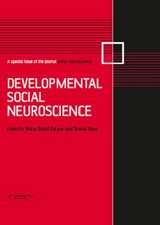Animal Models of Epilepsy: Methods and Innovations: Neuromethods, cartea 40
Editat de Scott C. Barabanen Limba Engleză Hardback – 29 mai 2009
| Toate formatele și edițiile | Preț | Express |
|---|---|---|
| Paperback (1) | 732.82 lei 38-44 zile | |
| Humana Press Inc. – 23 aug 2016 | 732.82 lei 38-44 zile | |
| Hardback (1) | 652.31 lei 3-5 săpt. | |
| Humana Press Inc. – 29 mai 2009 | 652.31 lei 3-5 săpt. |
Din seria Neuromethods
- 5%
 Preț: 347.58 lei
Preț: 347.58 lei - 15%
 Preț: 659.53 lei
Preț: 659.53 lei - 15%
 Preț: 665.08 lei
Preț: 665.08 lei - 18%
 Preț: 986.63 lei
Preț: 986.63 lei - 18%
 Preț: 953.03 lei
Preț: 953.03 lei - 18%
 Preț: 955.25 lei
Preț: 955.25 lei - 20%
 Preț: 1129.39 lei
Preț: 1129.39 lei - 20%
 Preț: 1252.07 lei
Preț: 1252.07 lei - 18%
 Preț: 1291.45 lei
Preț: 1291.45 lei - 18%
 Preț: 955.70 lei
Preț: 955.70 lei - 23%
 Preț: 705.40 lei
Preț: 705.40 lei - 18%
 Preț: 973.38 lei
Preț: 973.38 lei - 18%
 Preț: 964.86 lei
Preț: 964.86 lei - 18%
 Preț: 968.03 lei
Preț: 968.03 lei - 15%
 Preț: 662.95 lei
Preț: 662.95 lei - 15%
 Preț: 646.43 lei
Preț: 646.43 lei - 15%
 Preț: 649.71 lei
Preț: 649.71 lei -
 Preț: 395.29 lei
Preț: 395.29 lei - 19%
 Preț: 580.68 lei
Preț: 580.68 lei - 19%
 Preț: 584.13 lei
Preț: 584.13 lei - 19%
 Preț: 566.41 lei
Preț: 566.41 lei - 15%
 Preț: 652.17 lei
Preț: 652.17 lei - 15%
 Preț: 655.13 lei
Preț: 655.13 lei - 18%
 Preț: 1009.58 lei
Preț: 1009.58 lei - 18%
 Preț: 959.36 lei
Preț: 959.36 lei - 15%
 Preț: 652.49 lei
Preț: 652.49 lei - 15%
 Preț: 649.54 lei
Preț: 649.54 lei - 15%
 Preț: 649.87 lei
Preț: 649.87 lei - 15%
 Preț: 650.19 lei
Preț: 650.19 lei - 15%
 Preț: 648.42 lei
Preț: 648.42 lei - 18%
 Preț: 1039.22 lei
Preț: 1039.22 lei - 18%
 Preț: 963.15 lei
Preț: 963.15 lei
Preț: 652.31 lei
Preț vechi: 767.42 lei
-15% Nou
Puncte Express: 978
Preț estimativ în valută:
124.81€ • 130.33$ • 103.07£
124.81€ • 130.33$ • 103.07£
Carte disponibilă
Livrare economică 25 martie-08 aprilie
Preluare comenzi: 021 569.72.76
Specificații
ISBN-13: 9781603272629
ISBN-10: 1603272623
Pagini: 272
Ilustrații: XIII, 276 p. 58 illus., 19 illus. in color.
Dimensiuni: 193 x 260 x 18 mm
Greutate: 0.75 kg
Ediția:2009
Editura: Humana Press Inc.
Colecția Humana
Seria Neuromethods
Locul publicării:Totowa, NJ, United States
ISBN-10: 1603272623
Pagini: 272
Ilustrații: XIII, 276 p. 58 illus., 19 illus. in color.
Dimensiuni: 193 x 260 x 18 mm
Greutate: 0.75 kg
Ediția:2009
Editura: Humana Press Inc.
Colecția Humana
Seria Neuromethods
Locul publicării:Totowa, NJ, United States
Public țintă
Professional/practitionerCuprins
The Nematode, Caenorhabditis elegans, as an Emerging Model for Investigating Epilepsy.- The Genetics and Molecular Biology of Seizure Susceptibility in Drosophila.- The Albino Xenopus laevis Tadpole as a Novel Model of Developmental Seizures.- Zebrafish as a Simple Vertebrate Organism for Epilepsy Research.- Modeling Tuberous Sclerosis Complex: Brain Development and Hyperexcitability.- BK Potassium Channel Mutations Affecting Neuronal Function and Epilepsy.- Mouse Models of Benign Familial Neonatal Convulsions (BFNC): Mutations in KCNQ (Kv7) Genes.- Interneuron Loss as a Cause of Seizures: Lessons from Interneuron-Deficient Mice.- Imaging Seizure Propagation In Vitro.- Complexity Untangled: Large-Scale Realistic Computational Models in Epilepsy.- Organotypic Hippocampal Slice Cultures as a Model of Limbic Epileptogenesis.- Seizure Analysis and Detection In Vivo.- Viral Vector Gene Therapy for Epilepsy.- Neural Stem Cells in Experimental Mesial Temporal Lobe Epilepsy.
Recenzii
From the reviews:
“As a clinical epileptologist interested in fundamental aspects of epilepsy, I obtained a thorough update on the several frontiers of current epilepsy research from this lucid volume. Basic scientists will profit from these 14 distinct and succinct reviews that also treat methodology and pitfalls in detail. Thus, this work is recommended for basic science and clinical epileptologists as well as students of these disciplines.” (Warren T. Blume, Canadian Journal of Neurological Sciences, Vol. 37 (4), July, 2010)
“As a clinical epileptologist interested in fundamental aspects of epilepsy, I obtained a thorough update on the several frontiers of current epilepsy research from this lucid volume. Basic scientists will profit from these 14 distinct and succinct reviews that also treat methodology and pitfalls in detail. Thus, this work is recommended for basic science and clinical epileptologists as well as students of these disciplines.” (Warren T. Blume, Canadian Journal of Neurological Sciences, Vol. 37 (4), July, 2010)
Textul de pe ultima copertă
With its complex anatomical, molecular, electrophysiological and behavioral components, epilepsy provides the neuroscientist with nearly boundless opportunities to examine basic neurobiological mechanisms. In Animal Models of Epilepsy: Methods and Innovations, prominent investigators in the field examine several novel models of epilepsy in mice as well as in genetically tractable "simple" species such as Drosophila melanogaster (fruit flies), Caenorhabditis elegans (worms), Xenopus laevis (tadpoles) and Danio rerio (zebrafish). While covering some traditional models, the volume also explores the newest innovations like modeling seizure activity in silica and advanced strategies for seizure detection and gene therapy. As a volume in the successful Neuromethods™ series, the chapters provide clear, step-by-step protocols and thought-provoking reviews of the most recent advancements in the field.
Comprehensive and cutting-edge, Animal Models of Epilepsy: Methods and Innovations is an ideal guide for scientists who wish to expand our understanding of the pathogenesis of this neurological disorder.
Comprehensive and cutting-edge, Animal Models of Epilepsy: Methods and Innovations is an ideal guide for scientists who wish to expand our understanding of the pathogenesis of this neurological disorder.
Caracteristici
Provides an easily accessible reference for emerging animal models of epilepsy written by leading researchers in the field Details the latest innovations and methodologies currently being applied in the field of epilepsy research Covers a wide range of species and approaches Presents a variety of experimental strategies, covering simple model organisms, imaging and modeling technologies, gene therapy and genetic approaches to animal model development Moves beyond traditional animal models to encompass organisms and strategies that are at the cutting-edge of neuroscience Includes supplementary material: sn.pub/extras





















